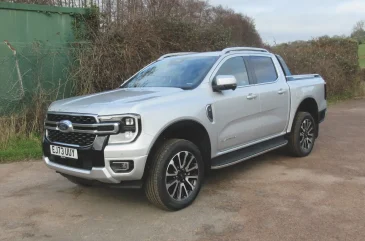
If it’s a 4×4 double-cab pick-up you’re looking for then your heart might suggest that you go for a Ford Ranger Raptor 3.0-litre V6 petrol with a stonking 292hp on tap.
Once reality has begun to seep in, however, then you may want to go for something that costs less to acquire, burns less fuel and pumps out less CO2. That is what your head will tell you to do.
At the same time, you probably won’t want to compromise when it comes to on-board creature comforts and off-roading ability.
The solution? Ford is likely to suggest that you opt for a Ranger Platinum 3.0-litre V6 EcoBlue diesel instead.
Like the all-conquering Raptor, it is available with a 10-speed automatic transmission. It is less powerful, agreed, but with 240hp to call on, and a bit more torque than a Raptor, it is scarcely a sluggard.
Furthermore, its payload capacity means that (unlike the Raptor) a business can claim back the VAT, because the taxman treats it as a commercial vehicle rather than a leisure tool.
Sitting close to the top of the Ranger range, the amount of equipment the Ranger Platinum comes with will not leave you feeling short-changed. We decided to sample what turned out to be a stylish yet practical piece of merchandise.
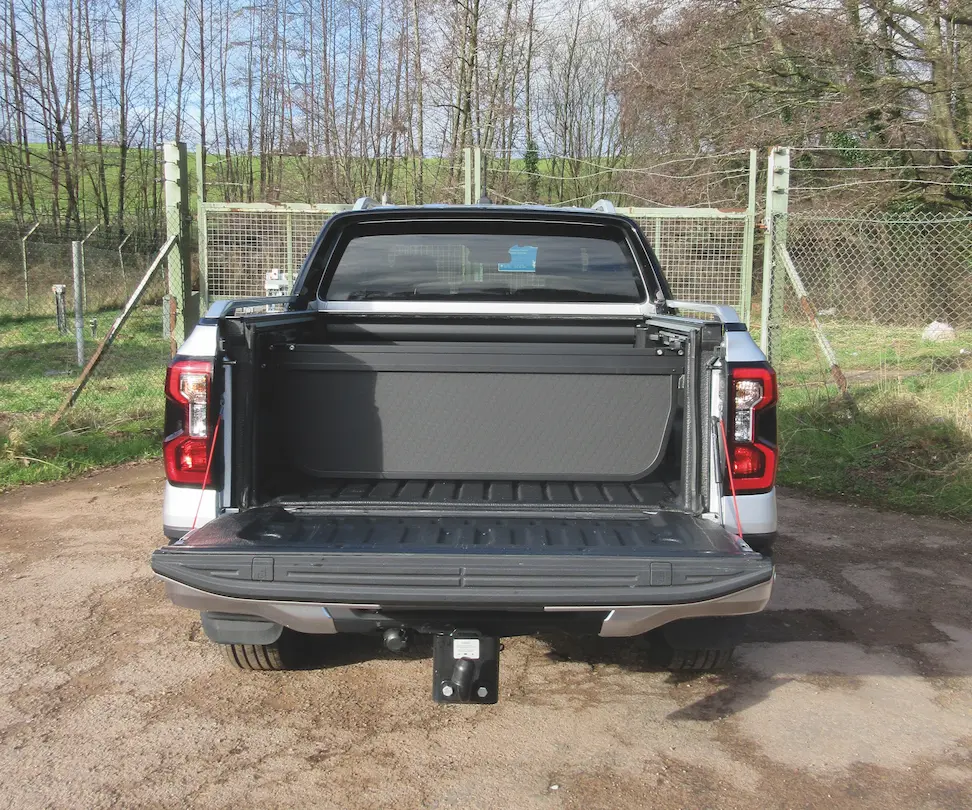
Load bay
The tailboard drops flat when released and opens onto a cargo bay with half-a-dozen tie-down points and a 400W 12v/240v power socket.
Access to the load box is aided by a step on both the nearside and offside of the vehicle’s body that allows you to climb up and reach in.
Our Ranger Platinum was equipped with an electrically powered cargo cover opened and closed using a switch on the dashboard – an extra-cost option, as was the moveable load bed divider. The cargo cover package includes a plastic liner.
LEDs illuminate the load area and should last for ages, as should the LED headlights, tail lights and daytime running lights.
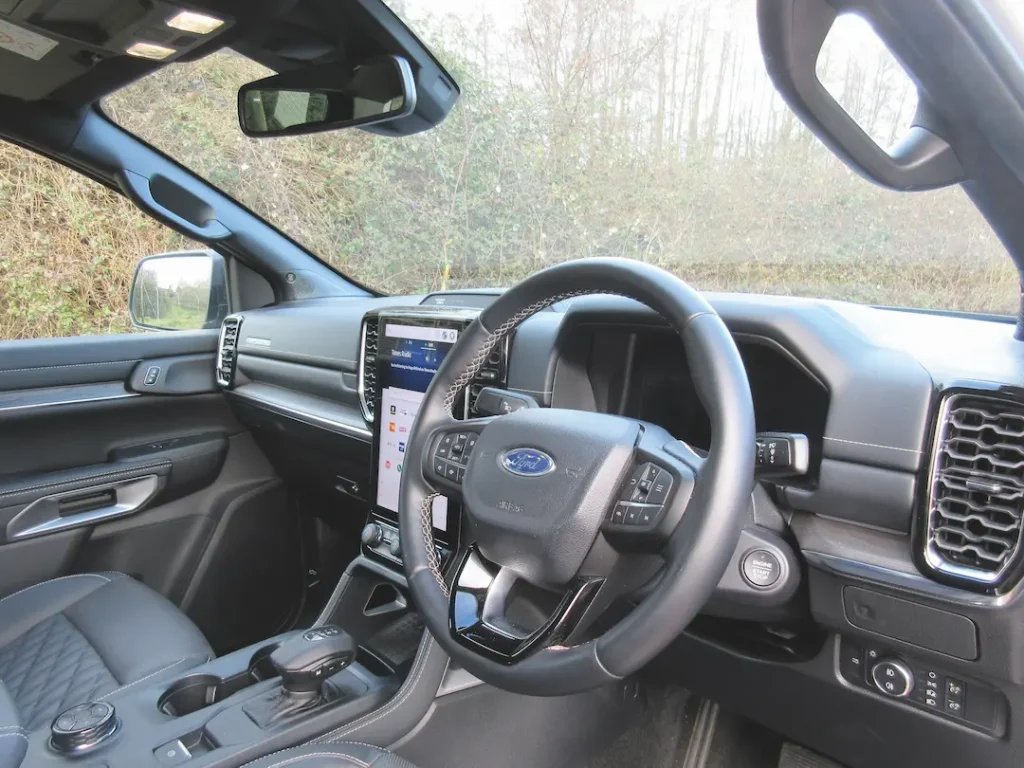
Interior and equipment
Any truck with heated front seats gets our vote, especially if they come with a facility that allows you to cool them on a hot day too. The Ranger Platinum does, and has made itself even more popular with us by the presence of a touchscreen that is easy to use.
Indeed, the big 12in screen that dominates the dashboard could scarcely be more user-friendly.
Facilities it controls include the DAB radio – the 10-speaker Bang & Olufsen stereo system is superb – and satellite navigation, and Ranger Platinum comes with wireless Android Auto and Apple CarPlay connectivity.
The screen is also used to switch the seat heaters on and off. However, a separate set of knobs is used to control the heating, ventilation and dual-zone air-conditioning system.
Good though the touchscreen is, we don’t want to be obliged to prod it when all we want to do is turn the heating up a notch.
Other handy features include keyless starting, big, power-operated, adjustable exterior rear-view mirrors that fold in electrically, electric windows and an electric parking brake.
Front fog lights are included in the deal, as is a heated windscreen. Front and rear parking sensors are fitted while front and rear-view cameras aid low-speed manoeuvring.
They allow the driver to see how close individual corners of the truck are to obstructions by using the touchscreen, and can offer a birds-eye view of everything surrounding the vehicle.
You will find remote controls for the radio on the height-adjustable and heated leather-trimmed steering wheel. The driver’s seat is height-adjustable too, with all adjustments controlled electrically.
A Traction Control System is fitted, and can be switched off. Cruise control should help you keep your speed down and burn less fuel as well as preserve your driving licence.
The Ranger Platinum boasts umpteen other driver assistance features. The line-up includes ABS, Electronic Stability Control and Roll Stability Control.
Present too are Active Park Assist, Adaptive Cruise Control with Lane Centring, Hill Descent Control, and Integrated Electric Trailer Brake Controller.
Our Ranger Platinum came with an optional technology package that includes a tow bar plus a further portfolio of safety devices, including Collision Mitigation System, Post Impact Braking, Reverse Brake Assist and Speed Sign Recognition.
Driver, front passenger and side airbags should provide the occupants with some protection if it all goes wrong.
In-cab stowage facilities include a roomy lockable glovebox with a lidded compartment above it, and a lidded box between the front seats that plays host to a 12v power point. The console between the seats accommodate a couple of cup-holders.
Look up, and you will see that a holder for your sunglasses sits just above the windscreen along with a bank of switches you can use to control ancillary equipment. Look down, and you will spot a wireless smartphone dock at the bottom of the dashboard.
There are bins in all four doors.
So far as the rear of the leather-trimmed cab is concerned, the two passengers nearest to the doors benefit from a decent amount of legroom. The middle passenger sits in far more cramped conditions; however, leg space is at a premium, and we wouldn’t want to perch there on a long journey.
If the centre seat is unoccupied then the middle section of its back can be pulled down and turned into a table for the other rear passengers to use. All three can avail themselves of the USB ports and the 240V power socket in the back of the console between the front seats.
Our demonstrator’s optional 20in alloy wheels with their black centre caps were shod with Goodyear Wrangler Territory 255/55 R20 tyres. A pressure-monitoring system keeps watch on their health.
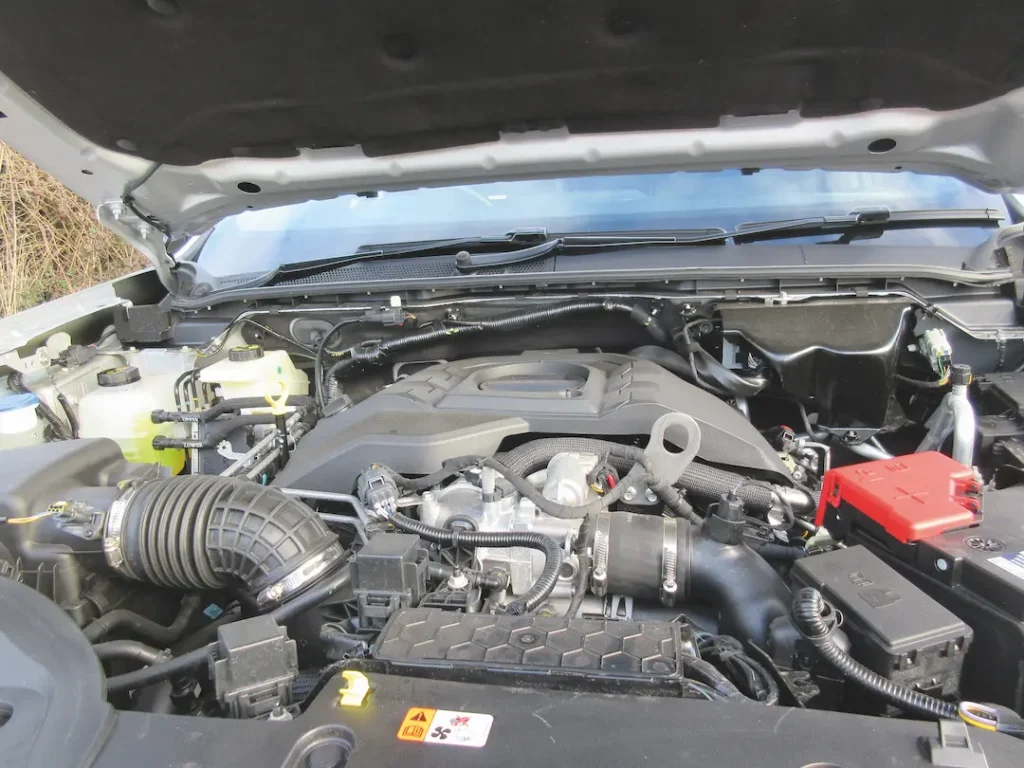
Powertrain
Delivering maximum power at 3,250rpm and a more-than-healthy 600Nm of torque at 1,750rpm to 2,250rpm, the six-cylinder common rail direct fuel injection diesel relies on AdBlue to help control its emissions.
To engage four-wheel-drive you rotate a dial between the front seats with four different settings.
Stick with 2H and you’ll remain in two-wheel-drive. Opting for 4H puts you into 4×4 mode for use off-road; 4L does the same, but gives you access to a set of low-ratio gears.
4A can be deployed if you need to call on four-wheel-drive to negotiate a slippery conventional road surface. In this context, it is worth noting that you can choose from a variety of different drive modes depending on what you are getting up to. The modes are Normal, Eco, Towing, Slippery, Mud and Sand.
Driving
The Ranger Platinum offers bags of power, and the 10-speed auto transmission delivers it smoothly. Acceleration from rest and up through the gears is strong, and the engine happily copes with high-speed motorway cruising without ever feeling overworked or excessively stressed.
For a big truck it handles well, sweeping through bends without showing any desire to disappear off into the undergrowth. It rides well too, coping easily with the gaping craters (as opposed to potholes) that now disfigure so many of our highways.
Noise is never an issue. The cab is well-insulated against any racket that might emanate from the outside world, or from the engine compartment.
We seldom felt the need to switch from automatic to manual mode. When we first did, we discovered that all we needed to do was to press a button on the side of the transmission lever then use buttons on the lever to go up and down the gears. Initially it is difficult to get used to, and you can be forgiven for feeling a bit awkward. After a few minutes, however, it becomes second nature, and you will soon be playing tunes on what is a remarkably forgiving gearbox.
Swing off a country lane, through a narrow gateway, and into a muddy field, and the Ranger Platinum is immediately at home. Churning through thick mud, up a steep incline, down the other side, then along a forest track with the odd boulder or two, we realised that it is a truck that can tackle the off-road terrain typically found in rural Britain without missing a beat.
Our demonstrator came with additional underbody protection, including a fuel tank guard, plus a locking back axle.
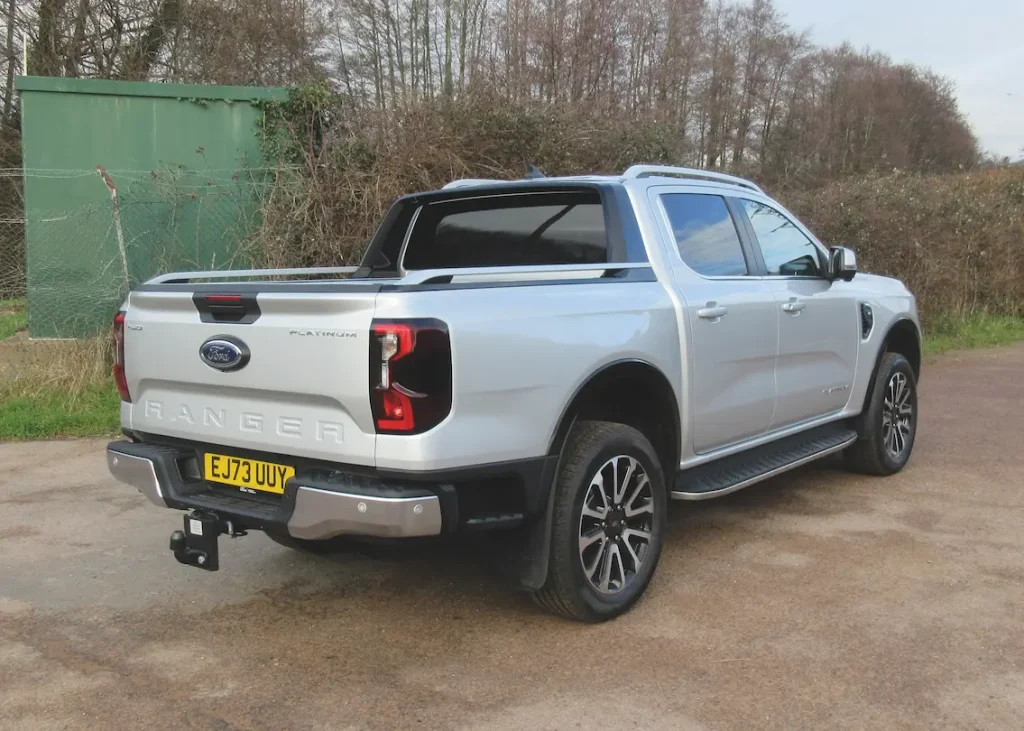
Operating
Service intervals are set at one year/12,500 miles while the warranty stands at three years/60,000 miles.
The former is not unreasonable given the unnoticed damage that can occur when you take a truck off-road. The latter is on the ungenerous side.
We returned a steady 30mpg; an improvement on the WLTP (Worldwide Harmonised Light Vehicle Test Procedure) official figure of 27.4mpg.
A built-in FordPass Connect modem allows you to monitor what’s happening with your vehicle remotely.
| Model | Ford Ranger Platinum 3.0-litre V6 EcoBlue ten-speed automatic 4×4 double-cab pick-up |
| Price (ex VAT) | £47,950 |
| Price range (ex VAT) | £28,550-£50,800 |
| Gross payload | 1,055kg |
| Load length | 1,544mm |
| Load width (min/max) | 1,224mm/1,584mm |
| Load bay height | 529mm |
| Load volume | 877mm |
| Gross vehicle weight | 3,350kg |
| Braked trailer towing weight | 3,500kg |
| Engine size/power | 2,993cc, 240hp @ 3,250rpm |
| Torque | 600Nm @ 1,750-2,250rpm |
| Gearbox | 10spd automatic |
| Fuel economy (combined WLTP) | 27.4mpg |
| Fuel tank | 80 litres |
| CO2 | 270g/km |
| Warranty | 3yrs/60,000 miles |
| Service intervals | 1yr/12,500 miles |
| Insurance group | 42E |
| Price as tested | £52,100 |
| Options | Metallic paint £600 20ins alloy wheels £750 Electric load area cover and bed-liner £1,800 Load bed divider £300 Underbody protection pack £100 Technology package £600 |
Rivals
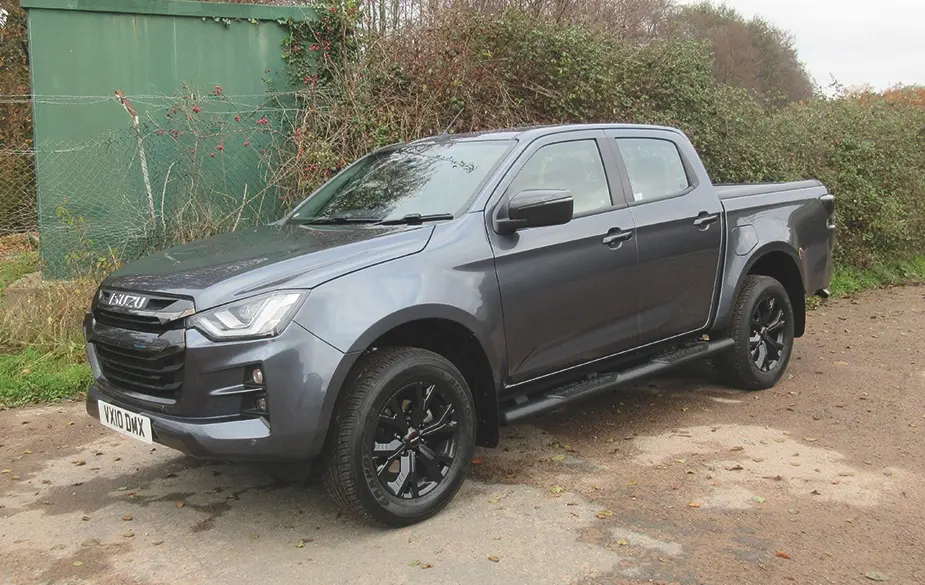
Isuzu D-Max
A recent extended off-road trip in sub-Saharan Africa showed that while the D-Max is not the most comfortable truck in the world, it is a remarkably effective performer in what was extremely demanding terrain. More power would be welcome, but is unlikely to be forthcoming as Isuzu concentrates on developing a 4×4 electric model set to arrive here in 2026. The emphasis on on-board safety devices in the current D-Max deserves praise.
| Price range (ex VAT) | £23,924-£51,324 |
| Gross payload | 1,045-1,205kg |
| Braked towing weight | 2,500-3,500kg |
| Engines | 164hp 1.9 diesel |
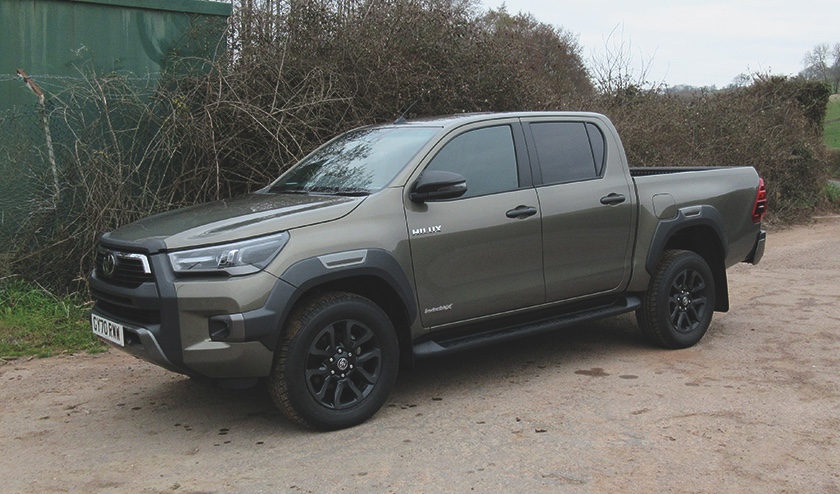
Toyota Hilux
Single and extended-cab Hiluxes have been expunged from the latest Toyota price list, which means the off-roader is now marketed as a double-cab only. The Hilux has a well-deserved reputation for being unbreakable; it comes with plenty of kit, the 204hp diesel has given it the power uplift it has long required and Toyota’s intelligent approach to warranty is worthy of applause. A Hilux will always be a safe bet.
| Price range (ex VAT) | £34,036-£60,687 |
| Gross payload | 1,010-1,105kg |
| Braked towing weight | 3,500kg |
| Engines | 150hp 2.4 diesel, 204hp 2.8 diesel |
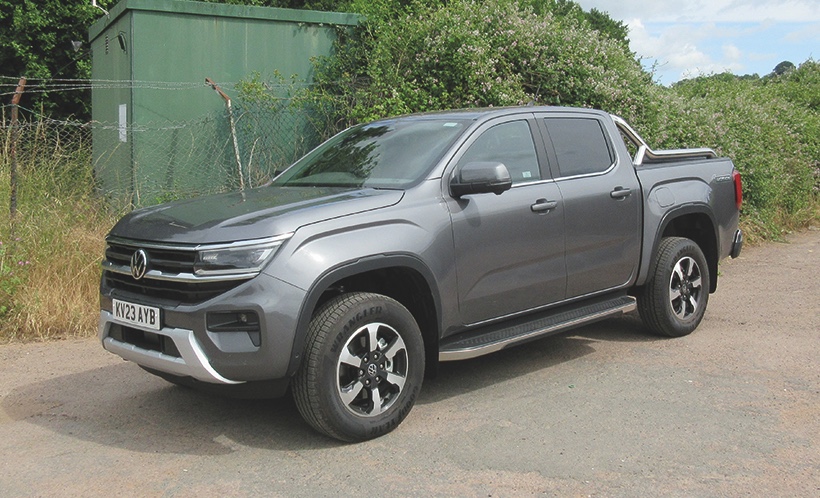
Volkswagen Amarok
Sitting on the same platform as Ford’s Ranger as the consequence of a joint venture deal between VW and the big blue oval, the Amarok is styled differently, and VW has elected not to offer it with a V6 petrol lump. Sold solely as a double-cab, it echoes VW’s strong stress on on-board safety equipment, and the warranty and servicing package that accompanies it is to be welcomed.
| Price range (ex VAT) | £33,990-£48,410 |
| Gross payload | 842-1,103kg |
| Braked towing weight | 3,420-3,500kg |
| Engines | 170hp, 205hp 2.0 diesel, 240hp 3.0 diesel |
The Final Verdict
| Design | 8/10 | A pile of intelligent features make it a safe as well as effective on- and off-roader. |
| Cabin | 8/10 | An easy-to-comprehend touchscreen makes for a pleasant working environment. |
| Ride | 8/10 | Suspension system insulates the cabin’s occupants from the worst of the shocks. |
| Refinement | 8/10 | A high level of build quality means that there is no squeaking or groaning. |
| Load area | 8/10 | Offers a decent payload capacity; Ford has given some thought to ease of access. |
| Handling/performance | 9/10 | More-than-generous torque proves to be of real benefit both on- and off-road. |
| Engine/transmission | 8/10 | A well-matched combination though switching to manual mode can feel a bit fiddly. |
| Standard equipment | 9/10 | A mountain of goodies should keep even the most finicky owner happy. |
| Operating costs | 7/10 | Service intervals are on the short side and the warranty could be more generous. |
| What Van? subjective rating | 8/10 | We don’t love it as much as the Ranger Raptor, but it’s probably more practical. |
| Overall rating | 81/100 |





